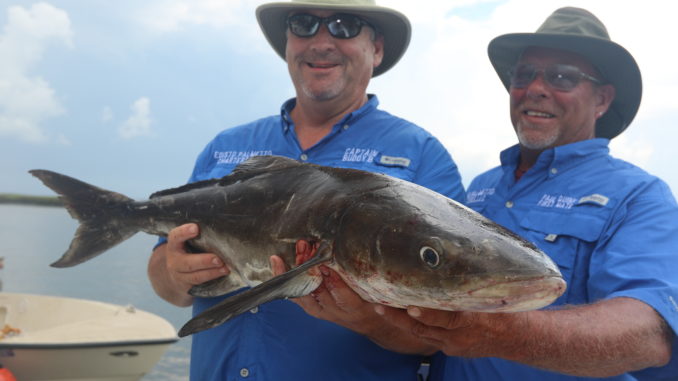
Guide says to fish cut bait on bottom in mid depths, but make sure you’re in clear water
Cobia have moved into St. Helena Sound, and anglers are catching them by fishing a variety of cut baits on the bottom. Capt. Buddy Bizzell of Edisto Palmetto Charters has been catching his share, and he said the key is persistence.
“The cobia are here, but you have to put in the time to catch them. These fish are finicky, and even though they’ll hang around your boat all day long, there is usually a small window of time that they’ll actively feed,” he said.
Bizzell’s best luck has been coming in a 45-minute period just as the tide is changing from slack to high or from slack to low. But he said it’s important to be out there before that happens, because setting up takes time, and there’s always a chance a cobia will slip up and bite before the tide change.
No matter how many boats are lined up in the sound, it’s always easy to spot Bizzell (803-603-2781). He noticed years ago that cobia follow sea turtles, so he takes one fishing with him. He keeps a large inflatable turtle in the water while he’s cobia fishing, believing it attracts the fish because of their curious nature. He also finds that cobia like to investigate noise, so he doesn’t mind making plenty on the water. He plays loud music throughout the day, and he uses chum bags to keep plenty of scent in the water. Keeping fresh bait on his hooks is another key to his success.
“I like to fillet baitfish so that no bones are on the bait. Cobia have soft mouths, and they’ll drop a bait if it’s bony. I check my baits every 10 minutes. If they lose their color and turn white, I’ll change them. You’ll catch plenty of sharks on old bait, but once they lose their color and smell, cobia rarely show any interest in them,” he said.
Bizzell fishes a Carolina rig that includes an 8/0 hook, a 3-foot section of 80-pound test leader, a heavy duty swivel, and a pyramid sinker that ranges from 2 to 6 ounces, depending on how strong the current is. He uses large pieces of bait, which he said deters small fish from biting.
Bizzell said the floor of St. Helena Sound is primarily a slope with three distinct depths. He likes to anchor in the middle depth while cobia fishing, but said it’s important to stay in clear water.
“You can see the line where muddy water meets the clear water, so you need to watch that and not let the muddy water overtake you. If it does, I just pull anchor and move 50 feet or so into the clear water. If it’s clear enough for me to see the foot of my outboard motor, I’m happy with that,” he said.





Be the first to comment